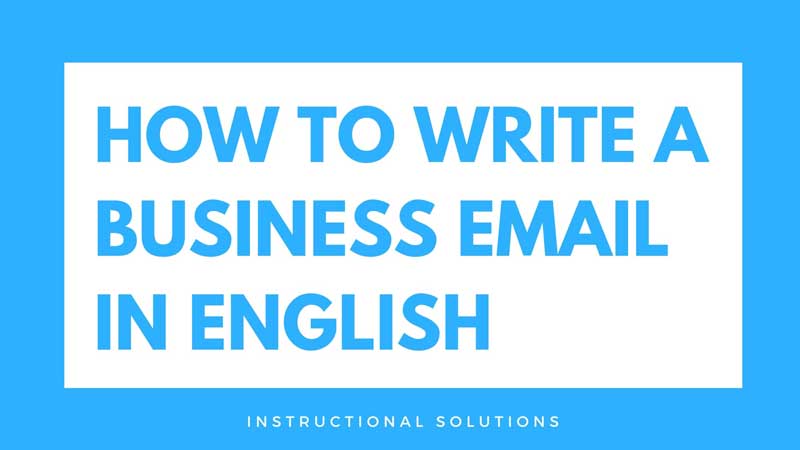A good business email is more than just using the correct grammar and vocabulary (though those are vitally important!). You also need to learn the right content and sequencing. Here’s an overview of the content and sequencing you need to use in order to write an effective email in business English.
See our guide on writing business emails here (for native speakers and advanced experience working in English).
1. Write a clear and informative English subject line
A clear subject line is a key element in a formal email (as well as informal!), but it is often overlooked, especially when we are in a hurry to send a quick email. Your email subject line should give your reader context before he or she even opens the email.
Keep it short, but make sure it is specific enough that your reader will (1) open it and (2) know what the email is about.
Here are some strong subject lines:
- Questions about the Costco Merger, reply needed
- Requesting a meeting re: the new hires
- ABC Project Status Needed by Tomorrow at Noon
Notice how these email subject lines are descriptive, yet concise. The reader understands exactly what information is included in the email.
2. Use an appropriate salutation
While it may be tempting to be casual in English emails, business emails still require a level of formality. It is not ok to open your email with “Hi!,” but “Hi John,” would be ok if the email is to a colleague with whom you are friendly.
In more formal emails, “Dear John:” would be best. (Notice that "Dear First Name" closes with a colon. A more casual salutation of "Hi First Name," closes with a comma.)
3. Write complete and easy-to-read body text
No matter the type of email you're writing, you need to include all of the information your reader needs to act. Make it easy for your reader by providing complete information, and keep the paragraphs short — seven lines of text in each paragraph is as long as an email paragraph should be. Shorter is better. Avoid complicated sentences.
Headings and lists help to make the information easier to absorb and help to ensure that you get the answer you need. The format of email writing matters.
Hint: If you have email attachments, any referenced attachments or links must be included in the email. Either name the file so that it is clearly identified or include the document title in parentheses immediately after you mention it in the email.
4. Add a strong, action-eliciting conclusion
Make sure that your conclusion guides the reader to exactly what you need him or her to do. For example, “Send me a list of the accounts you expected to be impacted by this merger by Thursday, June 30th. We will discuss this at the team meeting on Friday.”
5. Include an appropriate signature
As part of informal and formal email etiquette, make sure your signature is appropriate for your audience and includes all of the information they need to contact you. A good example of an email sign-off would be:
- Best regards,
- John Smith
- XYZ Company
- Address
- Phone Number
Sincerely could also be used in place of Best regards. Style Guides still approve of Sincerely as an appropriate close, but consider it a bit old-fashioned.
Hint: Depending on your email program, create a professional email signature that is automatically inserted in your business email.
Other considerations when writing English emails
Make sure to analyze your audience before writing and consider whether the email should be more formal or more informal. Do some research about the customs and culture of your audience. You may need to be more or less deferential than in your own culture, for example. (More info about considering your audience here.)
Double check your grammar before hitting send! Grammarly is an excellent tool to help identify and fix grammar and spelling errors. You can also step away from your English email for a few minutes or have a colleague look at it. Common errors in formal emails include incomplete sentences, inconsistency with capital letters, and missing hyphens.
Check for idioms. These are sayings that only make sense within a particular culture. (You can find a list of English idioms here) Since these are meaningless outside of their culture and business is rapidly globalizing, they would be inappropriate for most business communications.
English email example
Let's put all these tips together. Here's a sample email to a colleague:
Subject: ABC Project Status Needed by Tomorrow at Noon
Hello John,
What's the status of the ABC project? I need to know the following details to share at the weekly staff meeting:
-
- Updated timeline
- Amount spent / budget
- Any added project features
Please let me know the status by tomorrow (7/25) at 12:00pm.
Warmly,
Jane Doe
XYZ Company
Address
Phone Number
Unlike a personal email to, for example, a friend, this email is direct. It starts with the reason for the email, rather than warming it up with an introduction. Since the email is to a colleague, it also doesn't use formal language, but it's still professional. It includes bullets, clear sentences, an action-eliciting conclusion, and an appropriate sign-off. The grammar is also strong.
Writing effective emails in English takes practice for native and non-native English speakers alike. Instructional Solutions offers an online English Business Writing Course that can help you write strong business emails, improve overall email communication, and take your email writing skills to the next level.
Perfect your English business writing in our online self-paced course.
Get instructor feedback on your English writing today in our Business Writing for Non-Natives Course.
Learn more about the course

